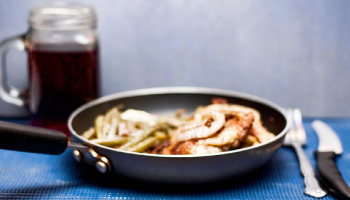Cooking dirty
Nothing smells worse than old food caught in burners, stuck to oven racks or clinging to microwave turntables. And almost nothing makes more smoke.
Older residence halls and apartment buildings tend to have years of gunk built up from sloppy cooks. So when you move in, give your burners and oven a good scrubbing. If you’ve got an oven full of gunk, remove the racks and wipe them down with a damp paper towel. Then use soapy water or an oven cleaner to wipe down the walls of the oven. If the burners on your stove are removable coils, take those apart, too, and let them sit in soapy water before scrubbing them down. Make an oven or microwave window sparkle with a mixture of vinegar and water. Remember to do all your cleaning when appliances are cool!
Ignoring Instructions
Remember that time you wrote your Lit paper without reading the rubric, and it took your marks months to recover? Ignoring the instructions on any packaged food is kind of like that, with a side of burnt mess.
Elon University senior Kristen Speir would be the first to tell you that nuking a Hot Pocket (it’s a type of pastry) for five minutes is a bad idea. Last year, her roommate made that mistake, not bothering to check a recommended cook time. And then she evacuated the entire building.
As it turns out, a box of Hot Pockets explicitly suggests a cook time of one minute and 40 seconds, and all other packaged food has similar cooking suggestions. No matter how well you think you can nuke Easy Mac, it’s always a good idea to check the directions in case you got that cook time mixed up with the Hot Pocket.
Recent Elon grad Caroline Peckels recalls an incident with frozen chicken that left her “freaking out and embarrassed.” She explains, “I didn’t realize you had to thaw it first. Everything started smoking, and I almost set the fire alarm off.” Unfortunately, frozen meat and hot pans don’t mix, a lesson new cooks can learn either by reading instructions or ruining dinner. (Hint: choose the first option!)
Getting preset-happy
You know those handy little buttons with cute illustrations of popcorn, pizza and baked potatoes on your microwave? Let’s just say they can produce some less-than-cute results. Unless you have a really fancy microwave (and most college students don’t), those buttons are set to handle only a very specific amount of the food they depict. Microwaves need longer cook times for more food, meaning that popcorn button will do nothing but burn your personal-sized mini-bag.
If you’re dealing with a food with no cooking instructions (like leftover pizza), try heating it for 30-second to one-minute intervals until it’s done. Then take note of how long it needed for next time, and write it on a post-it that you stick on the fridge.
Recipe illiteracy
So maybe you do follow instructions, and it’s still not going right. You use measuring cups for liquids, level your dry ingredients and faithfully use your meat thermometer, but your sauces are watery, your veggies are mushy, and you STILL can’t get your chicken to be anything but dry.
Before you throw in the dish towel, ask yourself this: Do you actually know what those directions mean? I mean, who knows the difference between a simmer and a boil anyway? And how in the world do you sauté something?
When you see unfamiliar words in your recipe, don’t turn into a cavewoman – act like the Internet-savvy student you are and Google it!
Article adapted from Her Campus
